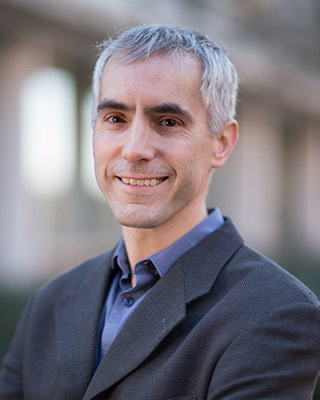October 24, 2024

Zylka, a professor of cell biology and physiology at UNC, studies genetic and environmental risks for autism, and molecular and brain mechanisms that underlie pain sensation.
Mark Zylka, Ph.D., is uncovering how genetic and environmental factors intertwine to influence neurodevelopmental disorders such as autism spectrum disorder (ASD). He traces his thirst for discovery to a high school science class, where students designed their own experiments.
Driven by this early enthusiasm, Zylka studied biochemistry as an undergraduate at Virginia Tech. He also gained valuable research experience through three summers as a fellow at the NIH campus in Maryland, where he explored how the hormone melatonin, which regulates sleep-wake cycles in mammals, functions. This research laid the groundwork for his growing fascination with neuroscience.
His focus sharpened during graduate school at Harvard, and later during a postdoctoral fellowship at the California Institute of Technology, where he studied genes involved in sensory neurons in rodents and humans.
“The brain is a complex organ where behaviors and diseases originate, yet we understand so little about its workings or how to treat brain disorders,” said Zylka, an NIEHS grant recipient.
Now a professor at the University of North Carolina at Chapel Hill (UNC), Zylka directs the school’s Neuroscience Center, which aims to enhance understanding of brain development and function, while identifying new therapies for neurological and psychiatric disorders.
Revealing the Genetics Behind Neurodevelopment
After joining UNC in 2006, Zylka’s interest in neurodevelopmental disorders deepened through discussions with UNC colleague Ben Philpot, Ph.D., who was researching Angelman syndrome, a rare genetic disorder that affects the nervous system, typically resulting in developmental delays, intellectual disabilities, and seizures.
Angelman syndrome stems from a mutation in a gene called UBE3A. The typical human brain has two copies of UBE3A — one inherited from the mother and one from the father, but the latter is typically turned off. People with Angelman have inherited a non-functioning UBE3A gene from their mother. Zylka and Philpot sought to develop a therapeutic approach that could activate the father’s dormant copy of the gene. To pursue this idea, they collaborated with Bryan Roth, Ph.D., a fellow UNC researcher with access to an extensive chemical library.
The team discovered that a cancer drug could activate the paternal UBE3A gene by inhibiting enzymes called topoisomerases, which are involved in DNA replication. This breakthrough not only pointed to a potential treatment for Angelman syndrome but also uncovered a genetic mechanism involved in ASD. Although Angelman syndrome is caused by a UBE3A deletion, ASD is associated with extra copies of the gene.
“Our analysis also identified environmental chemicals that might inhibit topoisomerases,” Zylka explained. “This inspired me to explore how these chemicals can influence gene expression and how these changes may contribute to neurodevelopmental disorders.”
Exploring Environmental Influences
In 2013, with funding from an NIH Director’s Pioneer Award, Zylka examined how environmental chemicals influence gene expression in neurons and contribute to autism risk. His team made a striking discovery: Genes mutated in individuals with autism are about four times longer than typical genes, and chemicals that inhibit topoisomerases reduce the expression of these long genes.
Zylka and collaborators then investigated other chemicals, such as pesticides and herbicides. They developed a fast, cost-effective method to screen about 300 chemicals and group them by their effects on gene expression. Notably, they discovered that a group of fungicides called strobilurins caused gene expression changes similar to those observed in individuals with ASD and other neurodegenerative diseases.
In 2019, Zylka received an NIEHS Revolutionizing Innovative, Visionary Environmental Health Research award, giving him the freedom to explore new research directions. Now, he’s honing in on more chemicals that might disrupt neurodevelopment, analyzing environmental exposures, and using mouse models and human cells to pinpoint genes that influence susceptibility to autism.
The Power of Collaborative, Multidisciplinary Research
Zylka attributes much of his success to working with experts in diverse research fields.
“Real scientific progress comes from stepping out of silos. We’re experts in certain areas, but collaboration is key,” Zylka reflected. “Bringing together diverse expertise makes the whole greater than the sum of its parts.”
For example, Zylka collaborated with Heather Stapleton, Ph.D., an exposure science expert and director of the NIEHS-funded Duke University Superfund Research Center, to analyze household dust samples for chemicals. Together, they found high levels of strobilurins in household dust and started investigating potential sources.
Zylka is also working with Stephanie Engel, Ph.D., and Kun Lu, Ph.D., researchers at the NIEHS-funded UNC Center for Environmental Health and Susceptibility, to assess exposure to fungicides from urine samples from pregnant women and their children. They detected the fungicide azoxystrobin in pregnant women and revealed it can be transferred across the placenta and enter the fetal brain. They also found the fungicides azoxystrobin and thiabendazole in urine samples from children.
“By working with others who have environmental and human samples, we can tackle questions we couldn’t fully answer with just animal models,” Zylka said. “It’s valuable to have scientists working on different, but overlapping, areas because bringing multiple faculty together can really drive a field forward.”


